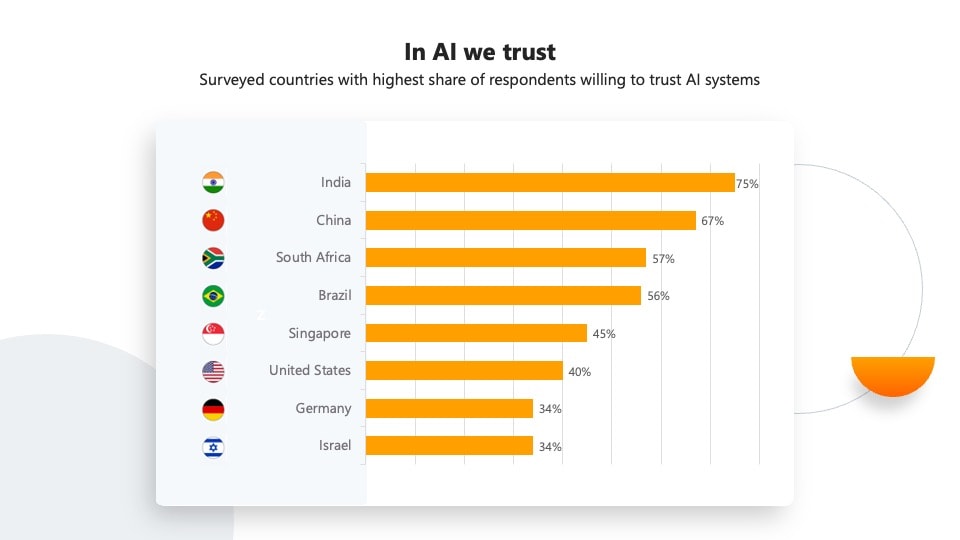
AI in data analytics: opportunities and challenges
Data analytics is a concept that has consumed the business world. Companies are able to understand their target audience and their product or service offerings better than ever before with an abundance of data stored in comprehensive warehouses.
As Artificial Intelligence (AI) has grown to become more complex and more used, it has been integrated into data analytics to revolutionize how data is interpreted and offer real-time insights. AI has changed the way companies collect data, identify patterns and trends, and make decisions.
However, the growth of AI within the data analytics realm has caused concerns in relation to data privacy, ethics, and governance.
The convergence of data analytics and Artificial Intelligence
Data analytics focuses on statistical analysis and pattern recognition.
AI, particularly machine learning, focuses on algorithms that learn from data, adapt, and make predictions of decisions with minimal programming. Intersecting these two fields amplifies their strengths and allows them to build off each other.
Machine learning models have the ability to uncover intricate trends and patterns that basic data analysis can not. Businesses are able to accurately forecast outcomes, optimize and automate processes, or make data-driven decisions with speed and accuracy.
While most data companies keep is structured, analyzing unstructured data is equally as important. Natural Language Processing (NLP) and computer vision techniques can derive valuable insights from text, images, and videos, expanding data analytics capability.
Learn more about Natural Language Processing in business:
- How is Natural Language Processing (NLP) used in business?
- NLP techniques: key methods that will improve your analysis
- How do NLP and IDP address business challenges?
- The future of Natural Language Processing
Overall, the convergence of these two realms has unlocked untapped information for many organizations.
Why is data analytics in Artificial Intelligence important?
Data analytics in artificial intelligence is important because it better informs decision-making, enhances efficiency and productivity, personalizes the customer experience, and manages risk.
Data-driven organizations can make decisions by uncovering correlations between large and complex datasets that require data mining techniques.
Companies are able to optimize strategies, reduce churn with AI deep learning algorithms, anticipate market shifts, and identify opportunities for growth.
Furthermore, AI-driven data analytics personalizes customer experiences by analyzing vast amounts of data to tailor products, services, and marketing strategies to the customer and target market.
Finally, vulnerability assessment and fraud detection are made accessible to more businesses due to AI’s ability to identify anomalies to detect potential risks and fraudulent activities.
Artificial Intelligence in data analytics: benefits and opportunities
Before getting into the challenges, it is important to expand on the many benefits AI in data analytics offers.
These benefits and opportunities include deep learning and big data, predictive and prescriptive analysis, customer insights, neural networks, and data visualization.
Deep Learning and Big Data: unlocking new horizons in Analytics
Deep learning is a subset of machine learning that trains algorithms called neural networks to recognize patterns, classify data, and make predictions.
The primary benefit of deep learning is that it can effectively analyze large quantities of data called big data.
In many organizations, millions of transactions happen each day. Each of these transactions has data attached to them, meaning the quantity of data the company collects is massive.
The term “deep” in deep learning means there are many layers within the trained neural networks. These multiple layers allow for a complex analysis and understanding of big data.
Deep learning has most notably seen success within autonomous vehicles and healthcare diagnostics due to its ability to automatically learn representations from raw data and make complex predictions.
Check out these articles:
- Importance of data science in IT industry
- Data-driven insurance: exploring the latest trends
- Business Intelligence: unlock the potential of your data and put it to use
AI’s role in predictive and prescriptive analysis
Predictive analysis takes historical data and statistical algorithms to forecast future outcomes. Prescriptive analysis takes predictive analysis a step further by suggesting possible actions and interventions to optimize or influence forecasted outcomes.
AI plays a transformative role in both predictive and prescriptive analysis, enhancing the capabilities and accuracy of these analytical approaches.
With AI, predictive analysis leverages machine learning algorithms to forecast future trends. These algorithms include regression, time series analysis, and neural networks.
The use of AI in predictive maintenance is often used in stock market forecasting, disease prognosis in healthcare, and customer behavior prediction in marketing.
Within prescriptive analysis, AI recommends the best course of action to achieve desired outcomes using computational models and algorithms.
Furthermore, AI aids in scenario planning, which aims to simulate different scenarios and prescribe actions. Scenario planning is widely used in supply chain management, resource allocation, and even healthcare for treatment recommendations.
AI-driven Data Analytics in customer insights
As previously touched on, complete and accurate customer insights can be generated with AI-driven data analytics.
These insights include personalized customer profiles, segmentation and targeting, and sentiment analysis. AI enables hyper-personalization by creating detailed consumer profiles from vast datasets.
These profiles encompass preferences, purchase history, and interactions across multiple touchpoints. Businesses use this data to tailor offerings and improve customer satisfaction.
AI and Machine Learning algorithms also excel in segmenting customers into finer segments based on nuances, similarities, and behaviors. Businesses can target highly specific groups, and they could use it as a competitive advantage.
Regarding sentiment analysis, Natural Language Processing algorithms analyze unstructured data like reviews and social media comments to help understand customer satisfaction levels and proactively enhance the customer journey.
Unveiling patterns: how neural networks transform complex data structures
Neural networks, a fundamental component of deep learning, excel at discovering patterns within complex data structures to extract valuable insights. Neural networks consist of interconnected layers of artificial neurons, each performing specific computations.
Each layer extracts increasingly abstract and complex features from the raw input, allowing the network to automatically sort data and unveil intricate patterns. Neural networks need to be trained in order for them to unveil these patterns.
They automatically learn relevant features from the data during the training process. Eventually, the networks will be able to learn by themselves to discover complex patterns and insights.
Within neural networks, there are two subsets that are used to handle high-dimensional data like images and text. Convolutional neural networks (CNNs) analyze images by learning hierarchical features. Recurrent neural networks (RNNs) process sequential data like time series or natural language.
These networks are adaptable and flexible depending on how they are trained. They can be trained on diverse datasets and applied to a wide range of problems.
Even though neural networks unveil intricate patterns within large sets of data, the depth of their functionality is a byproduct of how they are trained.
How AI pushes the envelope in data visualization
Once AI data analysis features insights within business analytics and gains valuable insights, AI can also be used to effectively visualise these insights. After all, customer data mean nothing unless they are conveyed in a way that management can understand.
Besides automating the insights it discovers, AI tools can also provide interactive visualisations that allow users to explore data dynamically. For example, users can drill down into visualizations at a finer level than usual.
Finally, AI can be used to generate real-time data visualisations that are updated as new data is retrieved. This capability is useful within applications pertaining to financial markets and other monitoring systems.
Data analytics and Artificial Intelligence: challenges
The benefits of AI within business intelligence are vast and make the future of data analysis shine brighter as the technology develops.
However, there are also many challenges associated with AI that have expanded into the realm of data analytics, creating the need for caution when using this great tool.
Ethical considerations: responsible use of AI in Data Analysis
Like many practices, there are ethical considerations that must be considered when using AI and deep learning algorithms.
First, AI algorithms like neural networks are often trained on biased or incomplete datasets, which perpetuate and exacerbate social biases, leading to unfair outcomes. Therefore, companies should be intentional with the databases they use.
In the realm of data privacy and protection, striking a balance between data utilization and safeguarding individual privacy rights is a must to avoid lawsuits that result from poor data protection.
Since AI-powered solutions must be trained on loads of existing data, companies must ensure that this data is attained legally and managed carefully.
Challenges in merging legacy systems with advanced AI solutions
Integrating legacy systems with advanced AI solutions creates several challenges due to differences in technology architectures, data formats, and operational paradigms.
These challenges have the ability to impede the seamless incorporation of AI into existing systems.
Regarding compatibility, legacy systems operate on outdated technology stacks or proprietary formats that are incompatible with modern AI frameworks. Bridging this gap requires adaptations and integrations that might not align quickly and seamlessly.
Furthermore, legacy systems may contain fragmented or inconsistent data stored in disparate formats. In order to integrate AI, a company must aggregate and clean these silos to ensure accuracy and uniformity, which can be complex and time-consuming.
Other challenges relating to integrating legacy systems with advanced AI solutions include security and compliance, skill gaps, costs, and resistance to change.
Merging new and old technology requires time, money, skills pertaining to both systems and buy-in from the people working within the organization.
Transparency and trust: building confidence in AI-generated data insights
To the naked eye, it may seem skeptical to make decisions based on AI-generated insights. However, this skepticism is totally normal and stems from the lack of transparency and trust around AI-driven data analytics solutions.
For example, an organization can encourage employee buy-in to a new AI solution by making AI models explainable and interpretable. Techniques like providing feature importance, model explanations, and decision rationales enhance transparency and build trust by demystifying AI-driven predictions.
Adhering to ethical guidelines and regulatory compliance also instills confidence in AI-driven insights. AI models that prioritize fairness, privacy, and compliance with data protection regulations build trust among users and stakeholders.
Finally, making AI interfaces user-friendly and continuously monitoring the functionality of AI solutions will encourage people to use the system due to the sense of familiarity and support they feel.
Weighing the opportunities and challenges for informed decision-making
Wrapping up the conversation on Artificial Intelligence (AI) in data analytics reveals a landscape teeming with both boundless opportunities and formidable challenges.
From the granular patterns uncovered by neural networks to the personalized customer experiences crafted by AI-driven analytics, the potential for innovation seems limitless.
However, amidst these opportunities lie challenges that demand diligent navigation and ethical foresight.
The ethical considerations surrounding AI’s role in data analytics underscore the importance of responsible use. Issues of data privacy, bias mitigation, and compliance with regulations must be addressed to ensure the ethical and equitable deployment of AI-driven insights.
Moreover, integrating advanced AI solutions with legacy systems poses hurdles related to technological disparities, data compatibility, and cultural shifts, necessitating a delicate balance between innovation and practical implementation.
Analyze data using AI/ML tools in partnership with Future Processing
Explainable AI, stringent ethical frameworks, user-friendly interfaces, and continuous monitoring stand as pillars fortifying confidence in AI-generated insights.
By embracing these strategies and advocating for ethical practices, organizations can harness the full potential of AI in data analytics while fostering a climate of trust, reliability, and responsible innovation.
As the journey through the terrain of AI and data analytics continues, navigating these challenges with foresight and adaptability will undoubtedly pave the way for a future where insights are not just powerful but also transparent and trustworthy.
If you are looking for an experienced and proven business partner for AI and data analytics activities, then get in touch!









